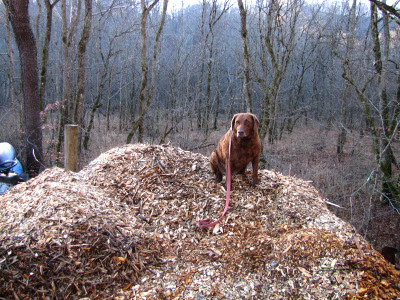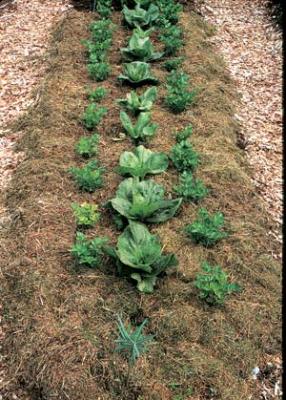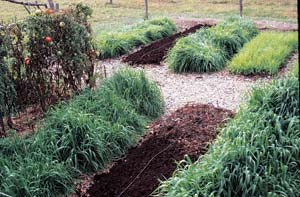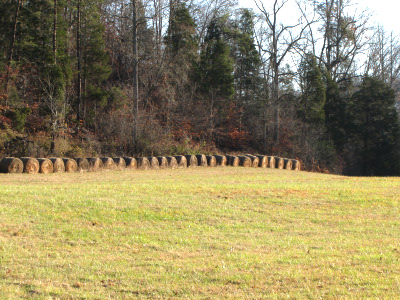
Free sources of garden mulch
 My
second gripe with Lee Reich's method is that, for most people, it will
devolve into buying a lot of off-farm mulches. If you put down a
new inch of mulch on a one acre garden every year, that means you've
come up with a whopping 134 cubic yards of mulch, or around 60+ large
pickup truck loads. I can't even imagine that much organic matter!
My
second gripe with Lee Reich's method is that, for most people, it will
devolve into buying a lot of off-farm mulches. If you put down a
new inch of mulch on a one acre garden every year, that means you've
come up with a whopping 134 cubic yards of mulch, or around 60+ large
pickup truck loads. I can't even imagine that much organic matter!
I've spent the last year
trying to rustle up enough scrounged
organic matter to mulch my garden, and we still devolved into buying
straw and rotted wood chip
mulch. A
continuous mulch won't pass
my permaculture test until I'm able to find all of the ingredients as
waste products or grow them myself. And Lee Reich didn't have
that many useful suggestions for non-storebought options:
- Compost --- This is only free if you make your own, which is possible if you can scavenge enough animal manure.
 Grass clippings ---
If we
lived in a city, I might be able to top off my garden with grass
clippings just by snagging bags from the curb, but that would be a lot
of bags since each large sack contains about a seventh of a cubic yard.
Grass clippings ---
If we
lived in a city, I might be able to top off my garden with grass
clippings just by snagging bags from the curb, but that would be a lot
of bags since each large sack contains about a seventh of a cubic yard.- Hay --- People always talk about finding spoiled hay for free, but this dream has never materialized for me. That said, if you were able to get a dozen of the big round bales of hay every year,that would top off your acre. (After you compost them well to kill the weed seeds, of course.)
- Leaves --- My mom generally comes through every year with a couple of dozen bags of autumn leaves that she finds by the curb. I adore these leaves, but they disappear so fast! Like bags of grass clippings, we'd need about 938 bags to mulch an acre garden.
- Sawdust --- Lee Reich and my father agree that you can often get sawdust for free at a local sawmill. This is on my list as a source of biomass to track down next year.
- Wood chips --- So far, this is the only kind of free biomass we've been able to find in large quantities. My favorite utility line workers dropped off another big truckload last week, and I've already earmarked it for about a dozen uses. I estimate that I'd have to get them to deliver about fifteen truckloads a year to keep me happy, which might be the most feasible of all of my mulch options. Lee Reich notes that wood chips make a perfectly safe mulch even on the vegetable garden as long as you don't work them into the soil.
 Cover crops --- The other
feasible option for a permaculture-friendly mulch is to grow your own
during the garden's off season in the form of cover crops. Lee
Reich seemed to be at about the same level of experimentation that I'm
at, trying to find a series of cover crops that winter kill or are
easily killed by mowing, mentioning barley, buckwheat, oats, rape, and
a sorghum-sudangrass hybrid as being reliably winter killed through
zone 6. He lists annual ryegrass as hardy in our zone, but notes
that it is very easy to mow-kill, along with all of the previously
mentioned cover crops except oats.
Cover crops --- The other
feasible option for a permaculture-friendly mulch is to grow your own
during the garden's off season in the form of cover crops. Lee
Reich seemed to be at about the same level of experimentation that I'm
at, trying to find a series of cover crops that winter kill or are
easily killed by mowing, mentioning barley, buckwheat, oats, rape, and
a sorghum-sudangrass hybrid as being reliably winter killed through
zone 6. He lists annual ryegrass as hardy in our zone, but notes
that it is very easy to mow-kill, along with all of the previously
mentioned cover crops except oats.
 I
guess it wasn't fair to think that Lee Reich would be able to provide
the silver bullet of free mulch products since this type of system is
bound to be unique to each person's area. I'll keep hunting down
as much biomass as I can, and will dream of finding enough to one day
mulch my whole garden. Meanwhile, on my daily walk, I covet the
neighbor's biomass.
I
guess it wasn't fair to think that Lee Reich would be able to provide
the silver bullet of free mulch products since this type of system is
bound to be unique to each person's area. I'll keep hunting down
as much biomass as I can, and will dream of finding enough to one day
mulch my whole garden. Meanwhile, on my daily walk, I covet the
neighbor's biomass.
| This post is part of our Lee Reich's Weedless Gardening lunchtime
series.
Read all of the entries: |
Want more in-depth information? Browse through our books.
Or explore more posts by date or by subject.
About us: Anna Hess and Mark Hamilton spent over a decade living self-sufficiently in the mountains of Virginia before moving north to start over from scratch in the foothills of Ohio. They've experimented with permaculture, no-till gardening, trailersteading, home-based microbusinesses and much more, writing about their adventures in both blogs and books.
Want to be notified when new comments are posted on this page? Click on the RSS button after you add a comment to subscribe to the comment feed, or simply check the box beside "email replies to me" while writing your comment.

If you need that much organic material for one acre, how does anything manage to grow in the wild?
Besides, an acre is 4000 m² (≈4800 yd²). Surely you don't need that big a garden just to feed two people?
The two acres are our garden and orchard and chicken area. I'd say our conventional garden is maybe half that, or a bit less. We don't technically need quite that much area, but it gives me space for all of my experiments, and to grow things that conventional home gardeners don't bother with (like grains, sunflowers for oil, potatoes and sweet potatoes, garlic, etc.) We also like having enough extra food to give some away, so we probably really feed the equivalent of three people.
I'd say that two people who were short on space and just wanted to feed themselves their basic vegetables could get by on an area the size of Lee Reich's garden.